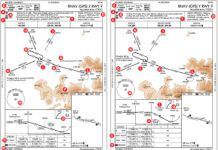Many of you have written to express confusion and disbelief about my “ILS Nuances” article in November. A couple of you even caught an important mistake I made. First, thanks to all of you for your notes. Now, let me recap a few things to hopefully help you (and me) better understand.
The Premise
The bottom line from that article that has caused so much discussion is that if you’re flying an ILS and intercept the glideslope outside the FAF, you could be busting some of the stepdown fix altitude restrictions.
An ILS is a seductive approach in that once we get on the localizer and glideslope, we tend to lose concentration on everything except staying on the localizer and the glideslope. We feel safe in the confidence of the crossed needles. In most cases, that’s not a problem. After all, the TERPS advise that altitude restrictions outside the FAF should be on or below the glideslope. Thus, if you do intercept the glideslope, even well outside the FAF, you’ll usually meet any altitude restrictions.
That, however, is the seductive part. We get so used to not having to worry about stepdowns—after all, we really can ignore them inside the FAF because they’re for the localizer, not the ILS—that we tend to ignore them wherever they are, so long as we’re on the glideslope. That’s reinforced by the glideslope usually also meeting altitudes outside the FAF.
“Usually,” but not always. And that’s the key. The takeaway for this is that when flying an ILS and you intercept and ride the glideslope outside the FAF, youmustcomply with the stepdown fix altitude restrictions. The glideslope will not guarantee you’ll meet those restrictions and in some cases the glideslope definitely passes below. If you see that you’ll bust one of the restrictions, you can usually just “hop” over it with minimal disruption to your otherwise stabilized descent.
Baby, It’s Cold Outside
In an unfortunate confluence of mistakenly blending two disparate concepts and some editing and layout errors, the original article also claimed that cold weather made the problem worse. To be clear, it doesn’t. But, let’s look at what the cold can do.
Altimeters are simply pressure-measuring devices. They have essentially no ability to adjust for temperature. That’s why some approaches have cold-weather corrections, but we’re jumping ahead.
Altimeters are designed around a “standard” atmosphere where a given pressure always—okay, mostly—corresponds to a given altitude. Cold condenses the atmosphere; that given altitude in the standard model actually occurs lower. So, when your altimeter reads 1000 feet MSL, assuming a standard atmosphere, you’re at 1000 feet. But, if it’s cold the actual altitude will be lower. Thus, just relying on your altimeter might bring you perilously close to something bad.
That’s what’s behind cold-weather adjustments on some approaches. The true altitude at DA could shrink to a dangerous level. Thus, you’re given an adjustment to add, say, 20 feet to the DA.
Frank Bowlin has studied this enough, now, that he could qualify for an advanced degree in cold-weather altimetry.




